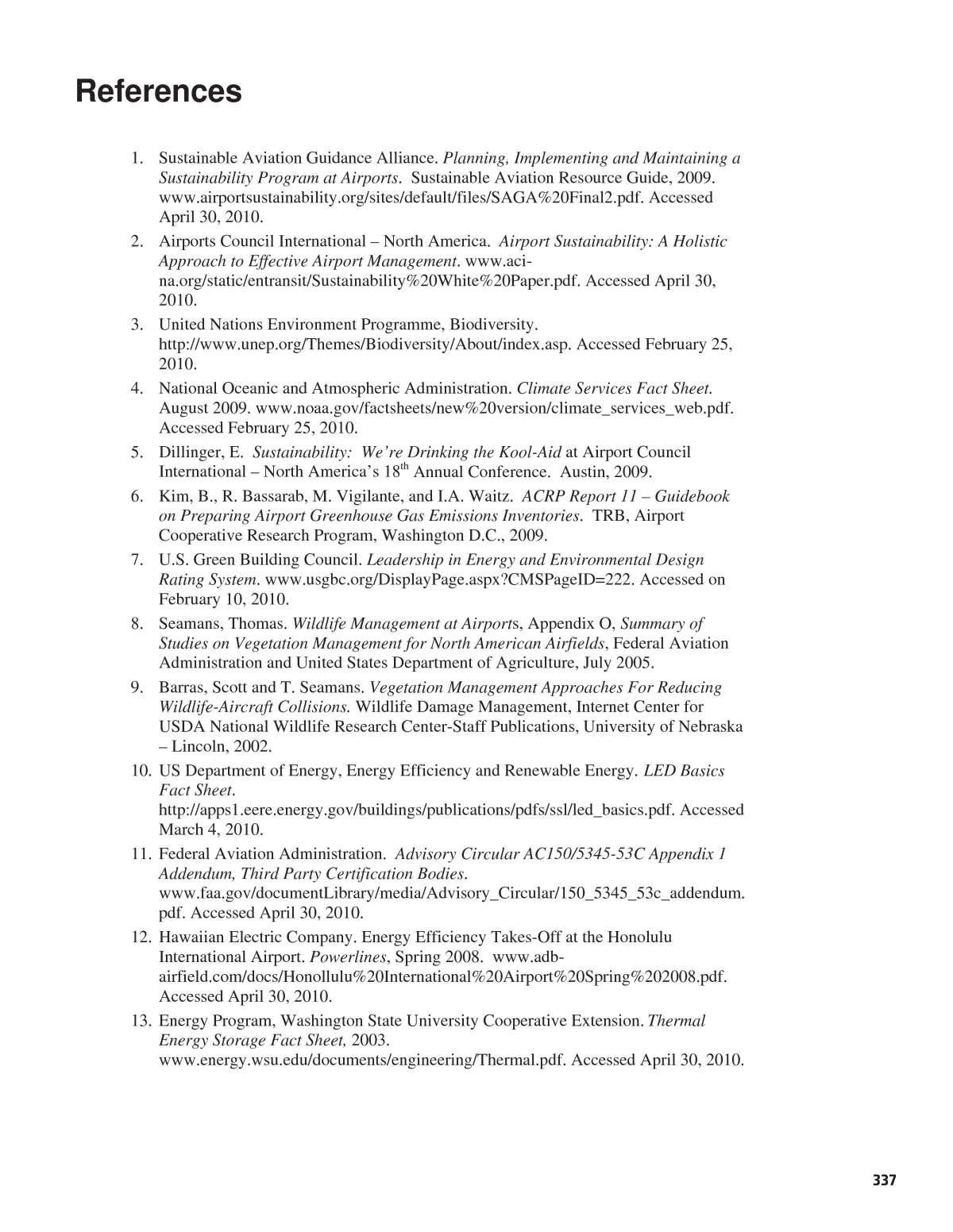

Below is the uncorrected machine-read text of this chapter, intended to provide our own search engines and external engines with highly rich, chapter-representative searchable text of each book. Because it is UNCORRECTED material, please consider the following text as a useful but insufficient proxy for the authoritative book pages.
337 References 1. Sustainable Aviation Guidance Alliance. Planning, Implementing and Maintaining a Sustainability Program at Airports. Sustainable Aviation Resource Guide, 2009. www.airportsustainability.org/sites/default/files/SAGA%20Final2.pdf. Accessed April 30, 2010. 2. Airports Council International â North America. Airport Sustainability: A Holistic Approach to Effective Airport Management. www.aci- na.org/static/entransit/Sustainability%20White%20Paper.pdf. Accessed April 30, 2010. 3. United Nations Environment Programme, Biodiversity. http://www.unep.org/Themes/Biodiversity/About/index.asp. Accessed February 25, 2010. 4. National Oceanic and Atmospheric Administration. Climate Services Fact Sheet. August 2009. www.noaa.gov/factsheets/new%20version/climate_services_web.pdf. Accessed February 25, 2010. 5. Dillinger, E. Sustainability: Weâre Drinking the Kool-Aid at Airport Council International â North Americaâs 18th Annual Conference. Austin, 2009. 6. Kim, B., R. Bassarab, M. Vigilante, and I.A. Waitz. ACRP Report 11 â Guidebook on Preparing Airport Greenhouse Gas Emissions Inventories. TRB, Airport Cooperative Research Program, Washington D.C., 2009. 7. U.S. Green Building Council. Leadership in Energy and Environmental Design Rating System. www.usgbc.org/DisplayPage.aspx?CMSPageID=222. Accessed on February 10, 2010. 8. Seamans, Thomas. Wildlife Management at Airports, Appendix O, Summary of Studies on Vegetation Management for North American Airfields, Federal Aviation Administration and United States Department of Agriculture, July 2005. 9. Barras, Scott and T. Seamans. Vegetation Management Approaches For Reducing Wildlife-Aircraft Collisions. Wildlife Damage Management, Internet Center for USDA National Wildlife Research Center-Staff Publications, University of Nebraska â Lincoln, 2002. 10. US Department of Energy, Energy Efficiency and Renewable Energy. LED Basics Fact Sheet. http://apps1.eere.energy.gov/buildings/publications/pdfs/ssl/led_basics.pdf. Accessed March 4, 2010. 11. Federal Aviation Administration. Advisory Circular AC150/5345-53C Appendix 1 Addendum, Third Party Certification Bodies. www.faa.gov/documentLibrary/media/Advisory_Circular/150_5345_53c_addendum. pdf. Accessed April 30, 2010. 12. Hawaiian Electric Company. Energy Efficiency Takes-Off at the Honolulu International Airport. Powerlines, Spring 2008. www.adb- airfield.com/docs/Honollulu%20International%20Airport%20Spring%202008.pdf. Accessed April 30, 2010. 13. Energy Program, Washington State University Cooperative Extension. Thermal Energy Storage Fact Sheet, 2003. www.energy.wsu.edu/documents/engineering/Thermal.pdf. Accessed April 30, 2010.
338 Guidebook of Practices for Improving Environmental Performance at Small Airports 14. Walker, Andy. Solar Water Heating, updated May 23, 2008. National Institute of Building Sciences. www.wbdg.org/resources/swheating.php. Accessed February 23, 2010. 15. Solid Waste Program, US Environmental Protection Agency, Region 8. Glenwood Springs Municipal Airport â Rubber-Asphalt Pavement Project, 2003. www.epa.gov/region8/recycling/grants.html. Accessed February 23, 2010. 16. Photograph. Vanasse Hangen Brustlin, 2009. 17. Photograph. St. Augustine-St. Johns County Airport Authority, 2009. 18. Federal Aviation Administration. National Plan of Integrated Airport Systems 2009- 2013. www.faa.gov/airports_airtraffic/airports/planning_capacity/. Accessed April 30, 2010. 19. Westchester County Airport. Environmental Policy Statement, 2002. www.westchestergov.com/jairport/pdfs/environmental_policy.pdf. Accessed April 30, 2010. 20. Jacobs Consultancy. Sustainability Management System Reference Document for Albuquerque International Airport, 2008. 21. City of Albuquerque. Double Eagle II Airport, Leadership in Energy and Environmental Design. www.cabq.gov/airport/double-eagle-ii-airport-leadership-in- energy-and-environmental-design-leed. Accessed April 30, 2010. 22. South Florida Water Management District. Naples Bay Surface Water Improvement and Management Plan, January 11, 2007. www.sfwmd.gov/portal/page/portal/pg_grp_sfwmd_regionalserv/portlet%20- %20stormwater%20management/tab8996095/naples%20bay%20swim%20plan%20f inal%20january%202007%20final.pdf. Accessed April 30, 2010. 23. Photograph. Paul Kennedy, Columbus Regional Airport Authority, 2010. 24. Photograph. Tallahassee Regional Airport, 2010. 25. RS&H for Tallahassee Regional Airport, 2010. 26. Photograph. Lynn Houston. Copyright 2010 Santa Barbara Municipal Airport. 27. Santa Barbara Municipal Airport. Solar Power Output Data from Fat Spaniel Monitoring site for SBA Quick Turnaround Facility. http://siteapp.fatspaniel.net/siteapp/simpleView.jsf?eid=329264. Data downloaded April 28, 2010.
